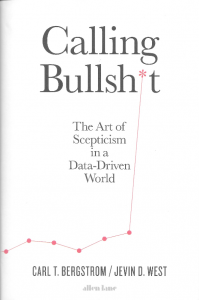The one sentence summary
We are surrounded by bullshit in many forms, but there are also many ways to spot it and refute it.
Can’t be bothered to read it? Too much screen time lately? Listen to the 5-minute podcast.
WHAT THE BOOK SAYS 
- This is all about scepticism in a data-driven world. Politicians are unconstrained by facts, science is conducted by press release, and start-up cultures elevate hype to high art. The world is awash with bullshit and we are drowning in it. The reason is that everyone is trying to sell you something and there is no limit to it because our complex language allows us to produce an infinite variety of it.
- Bullshit involves language, statistical figures, data graphics, and other forms of presentation intended to persuade or impress an audience by distracting, overwhelming, or intimidating them with a blatant disregard for the truth, logical coherence, or what information is actually being conveyed.
- It can be persuasive or evasive. It…
1/ Takes less work to create than to clean up.
2/ Takes less intelligence to create than to clean up.
3/ Spreads faster than efforts to clean it up.
- Sophisticated bullshitters need a theory of mind – to be able to put themselves in the place of the person they want to bullshit and to imagine what impression will be created by what type of bull.
- Paltering is talking insincerely. It’s misleading without lying outright, deliberately leading you to draw the wrong conclusion by saying things that are not technically untrue.
- “The amount of energy needed to refute bullshit is an order of magnitude bigger than that needed to produce it.” Alberto Brandolini
- “Falsehood flies, and truth comes limping after it.” Jonathan Swift
- “A lie will gallop halfway round the world before truth has the time to pull its breeches on.” Cordell Hull
- “The point of modern propaganda isn’t only to misinform or push an agenda. It is to exhaust your critical thinking, to annihilate the truth.” Garry Kasparov
- “An idiot can create more bullshit than you could ever hope to refute.” Uriel Fanelli
- “Bullshit is unclarifiable unclarity.” A. Cohen
- “At any given time, the chief source of bullshit with which you have to contend is yourself.” Neil Postman
WHAT’S GOOD ABOUT IT
- How to spot bullshit:
- Question the source of the information. Who is telling me this? How does he or she know it? What is this person trying to sell me?
- Beware of unfair comparisons.
- If it seems too good or too bad to be true, it probably is.
- Think in orders of magnitude. Bullshit numbers are often so off the mark that they are easy to spot.
- Avoid confirmation bias. Don’t use bull to confirm what you already think. Be aware of the illusory truth effect. The more often you see something, the more likely you will be to believe it.
- Consider multiple hypotheses.
- Truthiness is “the quality of seeming to be true according to one’s intuition, opinion or perception, without regard for actual logic and fact, or the like.” Comedian Stephen Colbert, 2005
- Mathiness refers to formulae and expressions that may look and feel like maths even though they disregard the logical coherence and formal rigour of actual mathematics. When a measure becomes a target, it ceases to be a good measure.
- What you see depends on where you look.
- Most studies are conducted on WEIRD people – Western, Educated, Industrialised, Rich, Democratic, which creates selection bias.
- Online, think more, share less.
- Calling out bullshit is crucial to a properly functioning social group, whether that’s a circle of friends, a community of researchers or the citizens of a nation. It is a performance utterance in which one repudiates something objectionable. Spotting bullshit is a private activity. Calling bullshit is a public activity. Methods include:
- Reductio ad absurdum – take statistics to ludicrous extremes.
- Be memorable. Say something distinctive.
- Find counterexamples. Things that say the opposite of the bullshit.
- Provide analogies.
- Redraw graphs and figures.
- When you refute bull, be correct, be charitable, admit fault, be clear, be pertinent. Look out for relevance, the speaker’s intention, the objector’s motivations, the audience, power dynamics, and judiciousness.
- A bullshitter has much in common with the well-actually guy – some who says: “Well actually…” and then goes on to utter something that does nothing to advance the truth.
WHAT YOU HAVE TO WATCH
- The authors are both scientists so there is a lot of scientific and statistical material to wade through.
